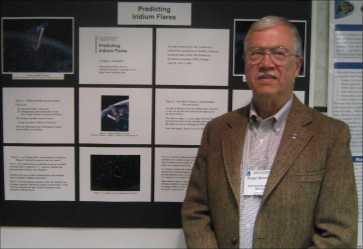Orbital Mechanics with Mathcad
(See Space Ornithology for Earth Satellite Tracking as a Hobby.)
Please note: Only individuals sponsored/paid by their employers will be admitted to the course. If you are an individual space professional interested in taking this course under the sponsorship of your employer, please bring this webpage to the attention of your employer.
INSTRUCTOR: Roger L. Mansfield
Mr. Mansfield is a space professional with more than 30 years of military, industrial, and academic experience. He began his space career as an orbital analyst for the Defense Meteorological Satellite Program (DMSP) in 1967. He was with DMSP six years (1967-73), then taught mathematics at the U.S. Air Force Academy (1973-74). He returned to civilian life and worked classified space projects at Philco-Ford, Palo Alto, California, and at Data Dynamics, Mountain View, California, from 1974 to 1976. As software engineer, supervisor, and principal engineer for space surveillance applications at Ford Aerospace and at Loral Command & Control Systems, he participated in, and then led efforts to develop algorithms and software for the 427M Space Surveillance Center (1976-81) and for the Space Defense Operations Center (1982-96). As assistant professor at CU-Colorado Springs (1996-98), he taught astrodynamics and numerical methods to graduate space engineers working for Lockheed Martin Astronautics at the Waterton Canyon facility near Denver, Colorado.
Mr. Mansfield's personal webpage at Mathcad Worksheets by Astroger describes just a few of the many Mathcad worksheets he has constructed to solve problems in the mechanics of Earth orbital, escape, flyby, and interplanetary trajectories. Details of his new book in orbital mechanics can be found at Topics in Astrodynamics.

"Predicting Iridium Flares" at DDA Conference, Boulder, Colorado, April 30, 2008 -- See http://astroger.com/~astroger/
COURSE OUTLINE:
Lesson 1. Mathcad as an Electronic Scratchpad. The notations and constructs of Mathcad as a scratchpad tool for doing scientific and engineering calculations.
Lesson 2. Mathcad as a Programming Language. The programming constructs introduced in 1996 that made Mathcad attractive for doing "industrial strength" orbital mechanics. The limitations as well as the unique capabilities of Mathcad: Mathcad vs. MATLAB, Mathematica, and Maple.
Lesson 3. Two-Body Orbit Propagation. Derivation of the relative equations of two-body motion. Kepler's Laws from Newton's Laws. Coordinate systems, orthogonal rotation matrices, and orbital elements.
Lesson 4. Element Set Transformations. Transformation of position and velocity to/from classical, nodal, equinoctial, and conic (cometary) orbital elements.
Lesson 5. Survey of Perturbation Theories. Methods of Numerical Integration with Cowell's Equations. Lagrange's Brackets and Lagrange's Planetary Equations. Variation of Parameters. General Perturbation Theories. Semi-analytical Perturbation Theories.
Lesson 6. NORAD and MPC Elements. How to obtain and use North American Aerospace Defense Command (NORAD) and Minor Planet Center (MPC) orbital elements. Types of orbits and types of missions. Space surveillance (NORAD) vs. space operations (DMSP, DSCS, DSP, GPS, Milstar, NASA, NOAA, NPOESS, etc.).
Lesson 7. First-Order, Secular Perturbation Theory ("GP1"). Development from first principles of a simplified theory that works well with NORAD two-line elements (TLE).
Lesson 8. Revolution Counting, Ground Traces, and Look Angles. How to use GP1 to count orbital revolutions (determine the "orbit number") accurately, and to calculate the Earth-fixed data of a ground trace. How to use GP1 with an Earth-fixed observer's geographical coordinates to calculate times and look angles for visible satellite passes.
Lesson 9. Launch Profiles and Nominals. The orbital segments of typical near Earth and deep space launch profiles and how to calculate nominal elements for them.
Lesson 10. Types of Observations. Optical and radar observations and the measurements that they contain. Survey of space sensor systems.
Lesson 11. Methods of Preliminary Orbit Determination. Gauss method with two position vectors. Gauss method with three optical (angles-only) observations. Herrick-Gibbs method with three radar (azimuth, elevation, and range) observations.
Lesson 12. Differential Correction of a Two-Body Orbit. How to use radar and optical observations, together with a preliminary orbital estimate, to improve the estimate.
A uniform two-body theory that employs Stumpff's c-functions and Goodyear's analytical, two-body state transition matrix will be presented and demonstrated. Optical and radar observations of the Near Earth Asteroid Rendezvous (NEAR) launch of February 1996 will constitute the realworld test case that is analyzed.
Lesson 13. Batch Filter for a Two-Body Orbit. How to use a batch filter to validate a two-body theory.
The worksheet implementation will integrate numerically not only the state estimate, but also the state transition matrix. It will demonstrate how one theory can be used to validate another, and in particular, will show that the highly complicated state transition matrix of Goodyear must have been implemented correctly in Lesson 12. Same test case as Lesson 12.
Lesson 14. Batch Filter with Perturbations. How the equations of a batch filter make it easy to account for the perturbative accelerations acting on Earth orbital and interplanetary trajectories.
The worksheet implementation will demonstrate that the equations for the batch filter can easily be extended to include perturbations, and will account for the bulge (J2) perturbations of a satellite orbit. Radar observations of the Galileo spacecraft's Earth 1 flyby of December 1990 will constitute the realworld test case that is analyzed.
(*Other course venues are possible. Inquire at the e-mail address below.)
(c) 2010 by Astronomical Data Service. Last updated 2010 February 19.
E-mail: astrocourse@att.net
|
Accesses:
|